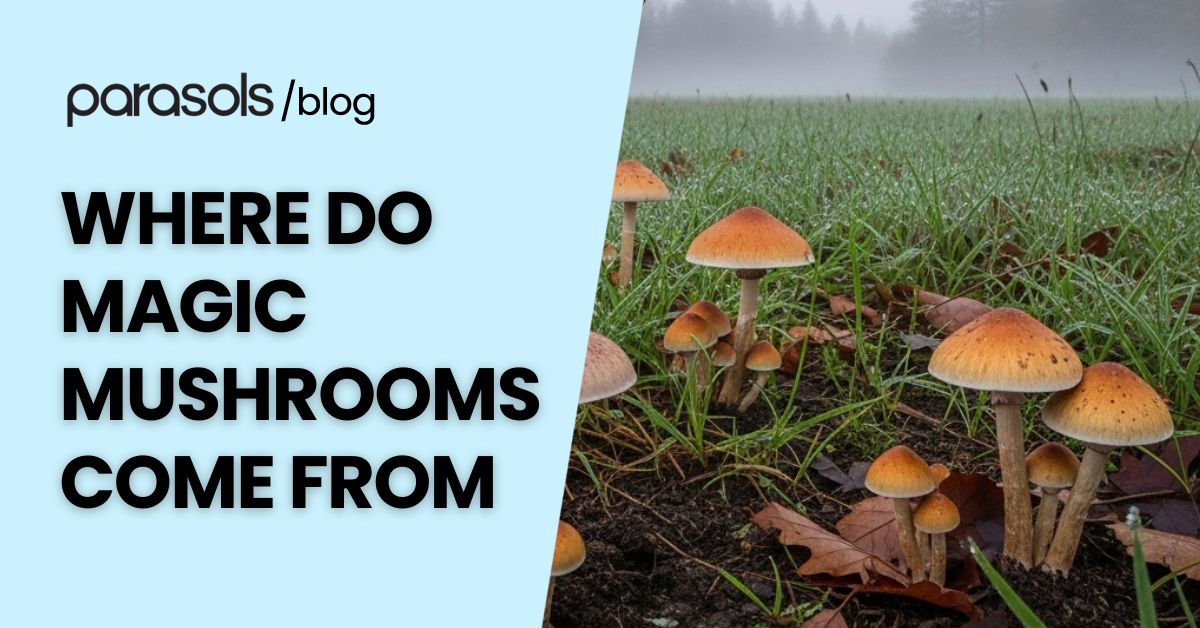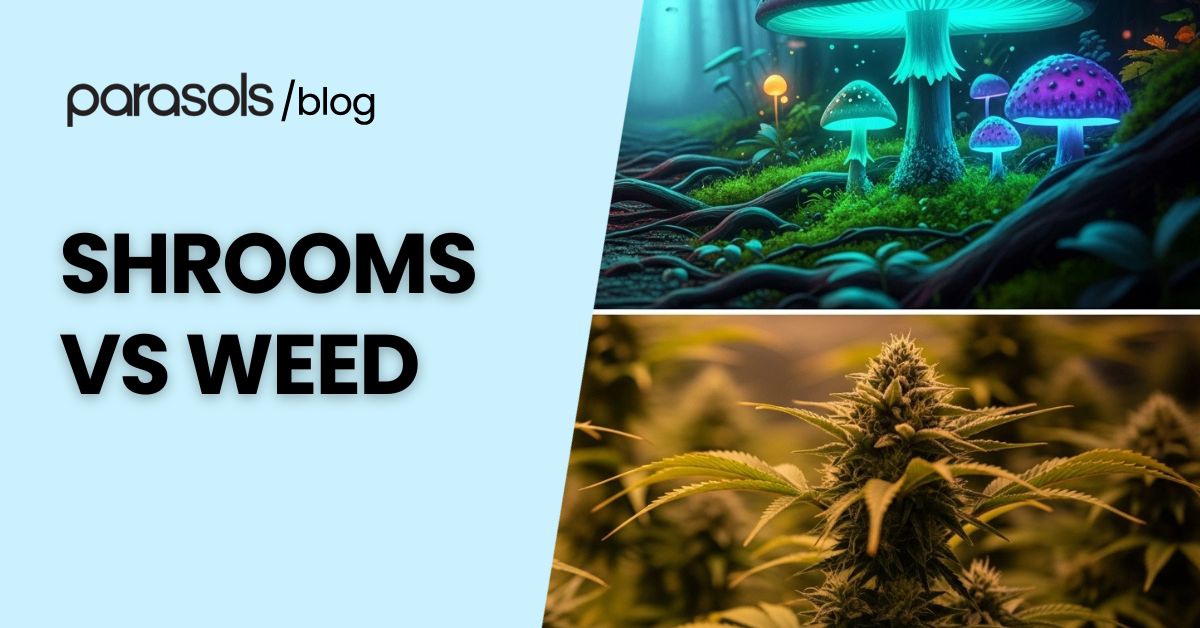Ever wondered where magic mushrooms come from and why people have been fascinated by them for centuries? These tiny fungi have sparked curiosity, creativity, and deep introspection across cultures.
From rainforests in Central and South America to misty fields in the Pacific Northwest, magic mushrooms—known scientifically as psilocybin mushrooms—have grown wild, carrying with them a long history of spiritual and psychedelic understanding.
Key Takeaways
- Magic mushrooms grow naturally in warm, humid environments across the world
- Common regions include Central and South America, the Pacific Northwest, and Northern Europe
- Most belong to the Psilocybe genus, such as Psilocybe cubensis and Psilocybe semilanceata
- They can be found in forests, grasslands, and pastures rich in organic matter
- Cultivation is possible but often illegal—research laws before growing or using
- Always source responsibly, as some poisonous mushrooms closely resemble psilocybin species
Where Do Magic Mushrooms Come From?
Magic mushrooms, or psilocybin mushrooms, come from various parts of the world where the climate supports their growth—typically warm, humid regions with rich soil. They naturally grow in forests, grasslands, and even pastures, especially in places like Central and South America, the Pacific Northwest, and Northern California.
These psychoactive mushrooms belong mainly to the genus Psilocybe, with species such as Psilocybe cubensis being among the most well-known.
Good Sources for Magic Mushrooms

Finding where magic mushrooms grow isn’t just about geography—it’s also about understanding the right environment, climate, and species. These mushrooms thrive under specific conditions that make certain regions around the world particularly rich sources for them.
Central and South America
Magic mushrooms have deep roots in Central and South America, where ancient cultures like the Aztecs and Mayans used psilocybin-containing mushrooms in spiritual and healing rituals. Warm temperatures, high humidity, and fertile soil create perfect conditions for Psilocybe species such as Psilocybe cubensis. Many traditional healers, often called medicine women, still use these mushrooms in ceremonies today.
Pacific Northwest and Northern California
In the Pacific Northwest and parts of Northern California, the cool, damp climate supports several types of hallucinogenic mushrooms. Species like Psilocybe cyanescens and Psilocybe azurescens grow wild in wooded areas, thriving on decaying plant matter. These regions are known for producing potent mushrooms with strong psychoactive properties that can lead to vivid visual and auditory hallucinations.
Urban Areas and Grasslands
Magic mushrooms also appear in urban parks, grassy fields, and farms, especially after rainfall. Psilocybe cubensis and related compounds often sprout in areas where livestock graze, as the spores develop well in nutrient-rich environments. However, identifying these mushrooms in the wild can be tricky since some poisonous mushrooms look similar, posing serious risks to anyone unfamiliar with mushroom species.
Other Global Hotspots
Beyond the Americas, parts of Europe, Asia, and Australia host their own native Psilocybe species. For instance, Liberty Caps (Psilocybe semilanceata) are common in the UK and northern Europe, growing in pastures and meadows. In these regions, people have used psilocybin mushrooms for centuries, both recreationally and for introspective or therapeutic psychedelic experiences.
Can You Cultivate Magic Mushrooms At Home?
Yes, you can cultivate magic mushrooms at home—but it’s important to note that growing psilocybin-containing mushrooms is illegal in many countries and U.S. states under the Controlled Substances Act.
If it’s legal where you live or you’re researching for educational purposes, here’s how the process generally works and some useful tips to consider.
- Start with spores: Mushroom cultivation begins with spores, the microscopic “seeds” of fungi. Psilocybe species, such as Psilocybe cubensis, can grow from spores in sterile conditions using nutrient-rich substrates like brown rice flour or vermiculite.
- Create the right environment: Magic mushrooms grow best in warm, humid spaces—typically between 70°F and 80°F. The fruiting body forms when conditions mimic a natural forest floor with moisture, airflow, and indirect light.
- Maintain sterility: Contamination from bacteria or mold is a major issue in home cultivation. Always use sanitized tools and containers to protect the psychoactive mushrooms during each stage of growth.
- Be patient: Psilocybin mushrooms grow over several weeks. During this time, mycelium spreads through the substrate before mushrooms appear. Patience ensures healthy, potent fruiting bodies with strong psychoactive effects.
How to Check Shrooms for Quality
Knowing how to check shrooms for quality can make the difference between a safe, positive psychedelic experience and an unpleasant or even harmful one.
- Look at the color: Quality psilocybin mushrooms often have golden-brown caps with lighter stems. Blue bruising is normal—it shows psilocybin’s ability to oxidize—but dark or black spots can indicate mold or decay.
- Check the texture: Fresh mushrooms should feel firm yet slightly flexible, not slimy or brittle. Dried mushrooms should snap cleanly rather than bend, as excess moisture can lead to bacterial growth or spoilage.
- Smell the mushrooms: A healthy batch has an earthy, natural scent. If the mushrooms smell sour, chemical-like, or rotten, they may be contaminated or mixed with other substances.
- Inspect for mold: Fuzzy white mycelium is normal during growth, but any green, black, or pink mold suggests contamination. Ingesting moldy mushrooms can cause serious health problems.
- Know the source: Always ensure mushrooms come from a reliable grower or a well-documented source. Wild-harvested fungi can be dangerous since some poisonous mushrooms closely resemble psilocybin-containing species.
- Observe potency clues: Larger caps and deeper blue bruising may suggest stronger psychoactive properties, though potency varies by species—Psilocybe cubensis, for instance, differs from Liberty Caps or other psilocybe species.
Final Thoughts

Magic mushrooms have fascinated people for generations—growing wild in forests, pastures, and even urban areas around the world. Whether identified in nature or cultivated carefully, these fungi hold both cultural history and scientific intrigue. Still, understanding their origins, effects, and legal status is essential before learning their use.
If you’re curious to learn more about their unique properties and potential benefits, study our definitive guide to psilocybin mushrooms for deeper insights into this mysterious world of fungi.
Frequently Asked Questions
Are magic mushrooms legal to use or possess?
The legal status of magic mushrooms varies widely across the world. In many countries and U.S. states, psilocybin and psilocin—the main psychoactive compounds—are classified as controlled substances under the Controlled Substances Act. However, some regions have decriminalized possession or allowed supervised therapeutic use in mental health treatment. It’s essential to check local laws before using or cultivating psilocybin-containing mushrooms, as penalties can be severe in places where they remain illegal.
What happens during a psychedelic experience with magic mushrooms?
When a user ingests psilocybin mushrooms, the body converts psilocybin into psilocin, which interacts with serotonin receptors in the brain. This can alter perception, mood, and thought patterns, leading to visual and auditory hallucinations, a distorted sense of time, and deep emotional or spiritual experiences. The intensity depends on the dose, the mushroom species, and the individual’s mindset.
Are magic mushrooms addictive?
Unlike many street drugs such as heroin or LSD, magic mushrooms are not considered physically addictive. However, frequent use can lead to tolerance, meaning users may need larger doses to experience the same psychedelic effects. While most people don’t develop dependence, psychological consequences can occur if use becomes a form of escape or self-medication.
What are the physical effects of magic mushrooms?
Physical effects can include mild nausea, muscle weakness, dilated pupils, or changes in coordination. These usually last for a short period, typically between four to six hours. In rare cases, a large dose or “heroic dose” can cause panic reactions, anxiety, or confusion as users struggle to discern fantasy from reality during the peak of the experience.
Can magic mushrooms be used for mental health treatment?
Recent studies suggest that psilocybin’s ability to influence serotonin pathways could help people manage conditions like depression, anxiety, and certain eating disorders. Under controlled settings, synthetic psilocybin has shown promise as part of psychedelic-assisted therapy. However, researchers stress that more research is needed before psilocybin can be safely integrated into mainstream medicine.
How can you tell the difference between magic mushrooms and poisonous mushrooms?
Identifying mushrooms in the wild requires expertise. While psilocybin mushrooms share traits like brownish caps and bluish bruising, some poisonous mushrooms look nearly identical. Consuming the wrong species can lead to severe poisoning or even death. If you’re not trained in mushroom identification, it’s safest to avoid picking wild mushrooms altogether.
What should someone do if they have a bad trip?
A bad trip can include fear, paranoia, or intense anxiety. If this happens, it’s best to stay calm, find a safe and quiet space, and have a trusted, sober person present for reassurance. Avoid mixing psilocybin with other substances or psychoactive drugs, which can worsen the experience. In severe cases involving panic or physical distress, seek medical help immediately.



Leave a comment
All comments are moderated before being published.
This site is protected by hCaptcha and the hCaptcha Privacy Policy and Terms of Service apply.